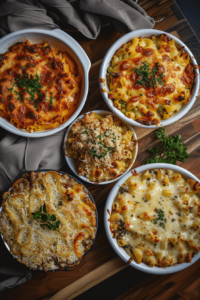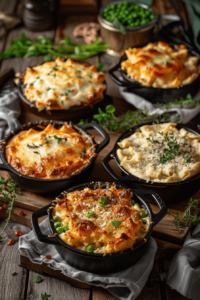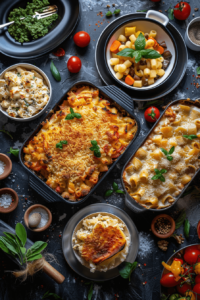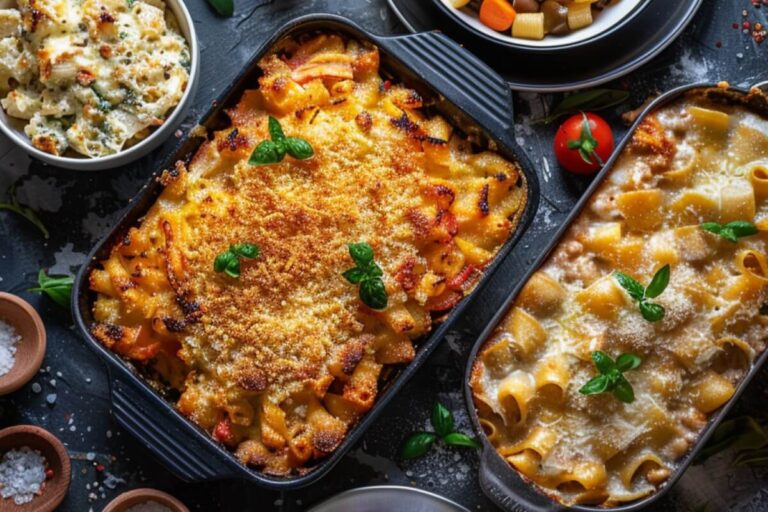Casseroles have long been a staple in kitchens across the globe, celebrated for their simplicity and heartwarming qualities. This versatile dish not only brings together various food groups in one pan but also encapsulates a rich history of culinary evolution and family traditions. Whether you’re a seasoned chef or a novice in the kitchen, understanding the fundamental components of a casserole can elevate your cooking game and help you whip up comforting meals that are both nourishing and delicious. In this article, we’ll dive deep into the four components to a casserole, exploring each element from its traditional roots to its modern adaptations, and even throw in a savory Tex-Mex Chili Bake recipe to get you started.
Introduction to Casseroles
There’s something quite magical about casseroles that have cemented their place in culinary traditions worldwide. Originating from the need for hearty meals that could be easily prepared and served, casseroles have evolved from simple peasant dishes to star attractions at dinner tables. Casseroles are particularly beloved for their ability to blend flavors and textures while keeping meal preparation fuss-free.

Typically, a casserole combines several layers that meld together during the baking process, creating a symphony of flavors that’s both satisfying and comforting. This multi-layered dish isn’t just about throwing ingredients into a dish; it’s about understanding how each component contributes to the dish’s overall flavor and texture. Casseroles are perfect for any occasion, whether it’s a family gathering, a potluck, or a simple weeknight dinner. Moreover, they offer endless versatility, accommodating any combination of proteins, veggies, and starches you might have on hand.
Stay tuned as we explore each of the four essential components of a casserole and learn how to master this classic dish.
Understanding the Four Components of a Casserole
To master the art of casserole making, it’s crucial to recognize and appreciate the role of each component that goes into this beloved dish. Each part of a casserole not only contributes its unique flavor and texture but also interacts with the other elements to produce a cohesive and delicious final product. Let’s break down these components:
The Starchy Base
The foundation of any good casserole, the starchy base, provides the bulk and helps in absorbing the flavors of the other ingredients. It’s not just about filling the belly but also about setting the stage for the flavors to meld beautifully. Common starchy bases include:
- Rice: Perfect for its absorbent properties, taking in the flavors of sauces and seasonings.
- Pasta: Offers a delightful texture and comes in various shapes and sizes to keep things interesting.
- Potatoes: Either sliced or mashed, they provide a creamy texture that complements both meat and vegetable components.
The Filling
The filling is where you can get creative with proteins and vegetables, which are the stars of the show. This layer defines the character of the casserole, providing the main flavor and textural contrasts. Popular filling choices are:
- Chicken: A versatile protein that pairs well with a variety of sauces.
- Beef: Rich and hearty, perfect for a robust casserole.
- Vegetables: Such as broccoli, bell peppers, and onions, which add color, texture, and nutritional value.
The Sauce
The sauce acts as the binder for the casserole, enveloping the base and filling in a rich, flavorful embrace. It’s crucial for moisture and can range from creamy concoctions to vibrant tomato-based sauces. Here are a few options:
- Cheese sauce: Creamy and rich, it’s a favorite in many classic recipes like macaroni cheese bake.
- Tomato sauce: Offers a tangy sharpness that can cut through the richness of other ingredients.
- Gravy: Perfect for a more savory, comforting casserole.
The Topping
Toppings add an essential textural contrast with a bit of crunch or a cheesy crust that makes every bite interesting. They also serve to protect the moisture and integrity of the other layers beneath them during baking. Common toppings include:
- Breadcrumbs: Provide a crunchy texture.
- Cheese: Melts into a delicious golden brown layer.
- Sliced vegetables: Like tomatoes or zucchini can add freshness and a slight crunch.
Table: Typical Casserole Components
| Component | Examples | Purpose |
|---|---|---|
| Base | Rice, pasta, potatoes | Provides structure and absorbs flavors |
| Filling | Chicken, beef, vegetables | Main flavor and texture providers |
| Sauce | Cheese sauce, tomato sauce, gravy | Binds the casserole and adds moisture |
| Topping | Breadcrumbs, cheese, sliced vegetables | Adds textural contrast and protects the ingredients |
By understanding these components, you can mix and match to create a casserole that suits your taste or make the most of what you have in your pantry. Next, we’ll take a closer look at how to assemble these elements into a delicious casserole recipe.
Recipe Example: Tex-Mex Chili Bake
Let’s put theory into practice with a hearty Tex-Mex Chili Bake that exemplifies how the four components of a casserole come together to create a flavorful and satisfying dish. This recipe is easy to follow and perfect for those who enjoy a bit of spice without overwhelming heat. You’re welcome to modify the amount of spice to match your taste preferences!

Recipe Elements
- Name Recipe: Tex-Mex Chili Bake
- Summary: A robust Tex-Mex chili topped with a golden cornbread crust, this casserole is the perfect blend of spice, meat, and hearty vegetables, making it an ideal comfort food for any occasion.
- Servings: Serves 6
- Prep Time: 20 minutes
- Cook Time: 1 hour (includes simmering and baking)
- Total Time: 1 hour 20 minutes
- Categories:
- Courses: Main dish
- Cuisines: Tex-Mex
- Keywords: chili bake, casserole, cornbread topping
Equipment Needed
A large cast iron skillet or Dutch oven and a 9×13 inch baking dish are essential for cooking the chili and then baking the entire casserole.
Ingredients
- 1 lb ground chuck — for rich flavor.
- 1 medium yellow onion, finely diced — adds sweetness.
- 1 green bell pepper, finely diced — provides a crisp texture.
- 1 can (16 oz) pinto beans, with liquid — for heartiness.
- 1 can (16 oz) fire-roasted tomatoes, with liquid — introduces a smoky flavor.
- 1 can (16 oz) low-sodium beef broth — enhances the overall moisture and savoriness of the dish.
- 1 tsp minced garlic — for a hint of pungency.
- 2 tbsp chili powder and 1 round tsp ground cumin — the backbone of Tex-Mex flavors.
- 1/4 tsp chili flake — adds a mild kick.
- 1/4 tsp ground cinnamon — a subtle warmth that complements the chili.
- 1 tbsp vegetable oil — for sautéing.
- Salt and pepper to taste
Instructions
- Preheat the oven to 400°F (204°C).
- Prepare the chili: In a large skillet, heat the oil over medium-high. Add the ground chuck, breaking it up as it cooks until browned. Add the onions and bell peppers, cooking until they are tender.
- Add flavorings: Stir in garlic, chili powder, cumin, chili flakes, and cinnamon, cooking until fragrant, about 1 minute.
- Combine remaining ingredients: Mix in the tomatoes, beans, and beef broth. Season with salt and pepper. Heat the mixture until it boils, then lower the heat to simmer. Let it cook uncovered for about 30 minutes, allowing the flavors to meld.
- Assemble the casserole: Transfer the chili to a 9×13 inch baking dish.
- Prepare the cornbread topping: Mix the cornbread according to package instructions and spread evenly over the chili.
- Bake: Place in the oven and bake for 20-25 minutes, or until the cornbread is golden and cooked through.
Nutrition
Approximately 450 calories per serving, making it a filling option that’s still reasonable in terms of caloric intake.
Notes
- Variations: The charm of this recipe is found in how adaptable it is. Swap out the meat for a vegetarian protein like quinoa or tofu for a plant-based version. Adjust the spices to increase or decrease the heat.
- Make Ahead: This casserole can be prepared a day in advance, kept refrigerated, and baked just before serving, making it perfect for busy schedules.
This Tex-Mex Chili Bake is a great example of how the different components of a casserole work together to create a dish that’s greater than the sum of its parts. Next, we’ll explore some helpful tips to perfect your casserole creations.
Casserole Cooking Tips and Tricks
Creating a perfect casserole involves a little finesse and some smart choices in the kitchen. Here are some practical tips and tricks that can help elevate your casserole from good to great, ensuring a delicious and crowd-pleasing result every time.

Equipment Essentials
The right equipment ensures even cooking and simplifies the entire process. Some helpful tools include:
| Equipment | Use Case |
|---|---|
| Cast Iron Skillet/Dutch Oven | Ideal for browning and sautéing ingredients and moving directly to the oven for baking. |
| Glass or Ceramic Baking Dish | Oven-safe and easy to serve directly from. |
| Sharp Knife | For preparing vegetables and proteins accurately. |
Pre-Cooking Proteins and Vegetables
- Proteins: Brown your proteins before assembling the casserole. This locks in flavors and adds depth.
- Vegetables: Sauté vegetables like onions, peppers, and mushrooms before adding them. This removes excess moisture and intensifies their taste.
Customize Your Sauces and Seasonings
- Cheese Sauce: Make your own creamy sauce using a roux base for a rich, indulgent layer.
- Tomato Sauce: Add fresh or dried herbs, garlic, and spices to canned tomato sauce to enhance the flavor.
- Gravy: Use pan drippings or stock with flour or cornstarch to create a luscious gravy.
Topping Variations
Switch up the toppings to add variety to your casseroles:
| Topping | Effect/Result |
|---|---|
| Breadcrumbs | Adds a crunchy, golden-brown layer to the dish. |
| Crushed Crackers | Introduces a buttery, flaky texture and extra crunch. |
| Cheese | Melts to form a gooey and slightly crispy crust. |
Make-Ahead and Freezing Tips
- Make-Ahead: Assemble the casserole a day before baking. This gives the flavors time to meld together.
- Freezing: Double the recipe and freeze one batch for future meals. Ensure that you tightly encase it in both plastic wrap and aluminum foil to avoid freezer burn.
Final Thoughts
These tips and tricks can help you navigate your way through the maze of casserole-making and tailor your creation to suit your preferences and dietary needs. Experiment with different combinations to find your ultimate casserole recipe that stands the test of time!
Make-Ahead and Freezing Tips
One of the greatest strengths of casseroles lies in their ability to be made in advance or frozen for later use. Whether you’re planning a family dinner or stocking up on ready-to-bake meals for busy nights, mastering these techniques will ensure that your casserole retains its flavor and freshness. Here are some practical make-ahead and freezing tips.
Make-Ahead Tips
Prepping casseroles ahead of time allows you to spend less time in the kitchen on the day of serving.
| Step | Instructions |
|---|---|
| Assembly | Assemble the entire casserole up to the point of baking. |
| Storage | Cover tightly with plastic wrap and foil to prevent moisture loss. |
| Refrigeration | Keep it refrigerated for up to 24 hours before baking. |
| Baking | Remove plastic wrap, cover with foil, and bake directly from the fridge. |
Freezing Tips
For long-term storage, freezing casseroles is a convenient option. Here’s how to prepare them for freezing:
| Step | Instructions |
|---|---|
| Partial Baking | Bake the casserole for half the usual time to firm up the ingredients. |
| Cooling | Allow the partially baked casserole to cool completely. |
| Wrapping | Wrap tightly in plastic wrap and foil to prevent freezer burn. |
| Labeling | Clearly label the casserole with the date and reheating instructions. |
| Freezing | Place in the freezer and it will stay fresh for a maximum of three months. |
| Thawing | Thaw in the refrigerator overnight before reheating. |
| Reheating | Reheat at 350°F (180°C) until heated through. |
Benefits of Make-Ahead and Freezing
- Time-Saving: Preparing casseroles in advance allows you to serve hearty, home-cooked meals without last-minute stress.
- Meal Planning: Freezing casseroles means you always have a ready-to-eat meal for those busy weekdays.
- Reduced Waste: Use up leftover proteins and veggies in your make-ahead casseroles to minimize food waste.
By following these practical steps, you’ll be able to enjoy the warmth and comfort of a casserole even on your busiest days!
Frequently Asked Questions (FAQs)
While casseroles are relatively straightforward to make, a few common questions often arise during preparation. Here’s a quick guide to help you troubleshoot and customize your casserole to perfection.
How Long Can Casseroles Be Stored?
Casseroles generally last for about 3-4 days in the refrigerator if stored properly in an airtight container. If you’re making one in advance or have leftovers, ensure it’s cooled down before transferring to the fridge. For longer storage, casseroles can be frozen for up to three months. Just wrap them well in plastic wrap and foil to lock in freshness.
How Do I Prevent My Casserole from Drying Out?
To prevent your casserole from becoming dry, make sure to use a proper ratio of sauce to other ingredients. The sauce should adequately coat the filling and base but not drown them, similar to how a béchamel sauce is applied in these crispy chicken tenders to enhance their flavor. If you notice the casserole drying out during baking, try covering it loosely with foil to retain moisture. Additionally, you can drizzle some extra sauce or stock before reheating.
Can I Replace Certain Ingredients?
Absolutely! Casseroles are highly versatile and forgiving, allowing you to swap out ingredients to suit your preferences or dietary restrictions. For instance:
- Swap pasta for rice or potatoes if gluten-free options are needed.
- Choose different vegetables based on seasonal availability or your taste.
- Replace meats with plant-based proteins like beans or lentils to make a vegetarian version.
Should I Cook My Ingredients Before Assembling?
It’s usually advisable to cook proteins and some vegetables ahead of time. Browning meats adds flavor and removes excess fat, while Pre-cooking vegetables reduces moisture that could otherwise make the casserole too watery, as seen in this hamburger casserole recipe that’s a family favorite. However, tender greens and already-cooked proteins like canned beans can be added directly.
Can I Make My Casserole in Advance?
Yes, casseroles are perfect for meal prep! Assemble the entire dish and store it in the refrigerator for up to 24 hours before baking. Alternatively, freeze it for up to three months and thaw it in the fridge overnight before baking.
Understanding these aspects ensures you can confidently approach any casserole recipe and tweak it to your liking. Experimentation is key, so don’t hesitate to try different combinations and develop your signature style!



